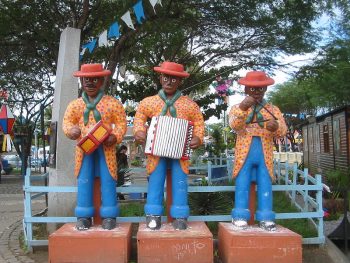What is forró? Posted by carol on May 30, 2019 in Brazilian Profile, Culture, Customs, Entertainment, Music, Video
That Brazil is a país enorme (huge country) with continental dimensions, needless to say, but as vast as its size is the diversity and cultural richness of its povo (people). From North to South and East to West, each of the 27 estados (states) that make up Brazil have its own cultural identity and together they form a variety of traditions, accents and typically Brazilian cuisines. However, there is always something that unites and overcomes the barriers of regions. If samba became the most characteristic and widespread musical style of Brazil, we can say that along with it is another typical Brazilian rhythm, that originated in the nordeste (northeastern) region of the country: forró. If you like music and would like to understand a bit more about this typically Northeastern style, you are in the right place.
Forró is a genuine artistic expression of the Brazilian northeastern sertão (similar to the Australian outback). Like samba, the word forró is not restricted to a musical rhythm, but is a broad cultural manifestation and can be used to name a dance style or even the festivities in which various styles of northeastern music are played. The very stories about the origin of the name “forró” can account for the amplitude of this term. For some researchers, it comes from the Luso-African word “forrobodó” that means “confusion” or “farra” (spree), but the most interesting version for its name was created by the population of the Northeast.
According to these stories, the term originated at the time of World War II, during the stay of American soldiers at a Navy base in the city of Natal. Countless feasts were held by the military, but only a few liberavam a entrada (admitted the entrance) of the population. When this happened, a poster would be placed by the door with the following phrase: “For all“. As the population did not know how to speak English, they ended up naming that type of festa (party) as “forró“, which would be a Brazilian way of saying “for all”.
Consisting basically of a triangle, accordion and zabumba, a kind of bateria (drum), the music known as forró usually has themes that focus on the cultural and daily aspects of the Northeastern people. Luiz Gonzaga is the ultimate expression of rhythm. Considered the Rei do Baião (King of Baião), he is one of the most important artists of Brazilian popular music, who in the 1940s toured the country with traditional trajes de vaqueiro (cowboy costumes) and his sanfona (accordion), achieving fame and spreading the Northeastern music that we now know as forró. Asa Branca (White Wing), his best known song, became a hymn about the força e esperança (strength and hope) of the poor people who survive in the hinterlands of the country waiting for the rain.
His songs influenced many Brazilian artists of different musical styles that honor him to this day. And the forró, popularized by Luiz Gonzaga has transformed over time, gaining electronic versions or even a more traditional appeal. Were you curious to listen to Luiz Gonzaga and some recent forró groups? “For all” who want to hear forró, check out the songs of “Asa Branca”, “My cowboy, my pawn” and “Xote da alegria”:
Asa Branca ao vivo (live):
Mastruz com leite – Meu Vaqueiro meu peão
Falamansa:
Um bom dia para todos! A good day for all!

Build vocabulary, practice pronunciation, and more with Transparent Language Online. Available anytime, anywhere, on any device.




